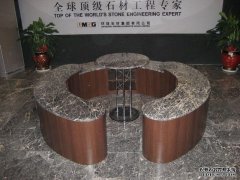Colored Stone Market
With the development of stone industry, overall, the colored stone market has "held up" considering the economy. The top and low ends have maintained their integrity, but the middle sector has felt a crunch, according to Richard Drucker, president of GemWorld International During his Top Colored Gemstones seminar, Drucker qualified his market observations: "Many colored stone prices are holding, they're just not selling, especially in the middle market. Price points that are selling well are under $1,200 and over $5,000 to $6,000." Topping Drucker's best-buy list is blue sapphire. Prices for heated stones of good and top quality have held. Commercial-quality goods, however, have softened in price by 5 to 10 percent, while prices for large stones are strong, up 10 to 15 percent over last year. Emeralds have been making a comeback over the last six to eight years, and production is good in Colombia and Zambia. Controversies over polymer fillers such as Permasafe linger, but many dealers disbelieve claims and assume that most emeralds are treated with oil, Drucker said. Tourmaline is another good buy, and Drucker noted that Nigerian rubellite is plentiful. This affordable red tourmaline has become a hot seller because of higher clarity.
Blue zircon, a less-expensive alternative to blue sapphire, is another strong seller. Zircon overall remains popular with retailers. Spinel also is popular with retailers, and most colors, except red, are plentiful. Because it's still largely unknown, many consumers believe spinel is a new product. Many retail buyers have been exploring unusual pearl products such as petal, wing, soufflé, and baroque pearls. But "beadless" pearls, which recently entered the market, have sparked nomenclature issues. Chinese-freshwater-pearl producers are using small pearls as nucleus inserts, which makes the pearls appear natural. As a result, labs have difficulty labeling the product. Supplies of various qualities of Tahitian pearls will soon enter the market. A quasi-government group that exported only finer goods was disbanded. The group's export policies forced many Tahitian pearl farms to close, hurting production. In other pearl news the University of Florida is producing cultured conch pearls. Drucker said demand for pink sapphire has dropped 30 to 35 percent. Yellow sapphire demand has also waned, but not in India. "There's big demand in India for yellow sapphires—even beryllium-treated material," Drucker said. Ruby is the subject of major controversies, including the ongoing storm over lead-glass-filled ruby; bloody anti-government demonstrations in Bangkok, Thailand, that have all but stopped gem trading there; and the ban on Burma rubies, which will be intact for the "foreseeable future" according to Drucker. Because of the Burma ban, China is emerging as a source for ruby. Mozambique and Madagascar remain strong sources, but ruby production has stopped in Tanzania (Winza).
Monthly Recommendation
Recommended News





![[Neoclassical] minimalist furniture choices Italian [House]](/uploads/allimg/160705/5-160F5134T4541-lp.jpg)

